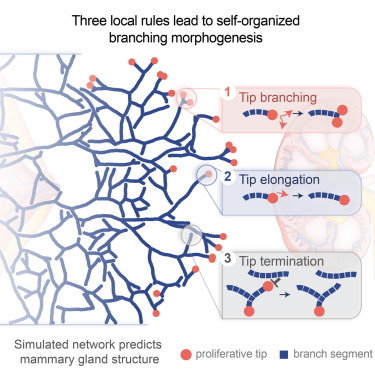Our official English website, www.x-mol.net, welcomes your
feedback! (Note: you will need to create a separate account there.)
A Unifying Theory of Branching Morphogenesis.
Cell ( IF 45.5 ) Pub Date : 2017-Sep-21 , DOI: 10.1016/j.cell.2017.08.026 Edouard Hannezo 1 , Colinda L G J Scheele 2 , Mohammad Moad 3 , Nicholas Drogo 4 , Rakesh Heer 3 , Rosemary V Sampogna 5 , Jacco van Rheenen 2 , Benjamin D Simons 1
Cell ( IF 45.5 ) Pub Date : 2017-Sep-21 , DOI: 10.1016/j.cell.2017.08.026 Edouard Hannezo 1 , Colinda L G J Scheele 2 , Mohammad Moad 3 , Nicholas Drogo 4 , Rakesh Heer 3 , Rosemary V Sampogna 5 , Jacco van Rheenen 2 , Benjamin D Simons 1
Affiliation

|
The morphogenesis of branched organs remains a subject of abiding interest. Although much is known about the underlying signaling pathways, it remains unclear how macroscopic features of branched organs, including their size, network topology, and spatial patterning, are encoded. Here, we show that, in mouse mammary gland, kidney, and human prostate, these features can be explained quantitatively within a single unifying framework of branching and annihilating random walks. Based on quantitative analyses of large-scale organ reconstructions and proliferation kinetics measurements, we propose that morphogenesis follows from the proliferative activity of equipotent tips that stochastically branch and randomly explore their environment but compete neutrally for space, becoming proliferatively inactive when in proximity with neighboring ducts. These results show that complex branched epithelial structures develop as a self-organized process, reliant upon a strikingly simple but generic rule, without recourse to a rigid and deterministic sequence of genetically programmed events.
中文翻译:

分支形态发生的统一理论。
分支器官的形态发生仍然是人们长期感兴趣的课题。尽管人们对潜在的信号通路了解很多,但仍不清楚分支器官的宏观特征(包括其大小、网络拓扑和空间模式)是如何编码的。在这里,我们表明,在小鼠乳腺、肾脏和人类前列腺中,这些特征可以在分支和湮灭随机游走的单一统一框架内定量解释。基于大规模器官重建和增殖动力学测量的定量分析,我们提出形态发生源于等能尖端的增殖活动,这些尖端随机分支并随机探索其环境,但中立地竞争空间,当靠近邻近导管时变得增殖不活跃。这些结果表明,复杂的分支上皮结构作为一个自组织过程而发展,依赖于一个极其简单但通用的规则,而不依赖于严格且确定的遗传编程事件序列。
更新日期:2017-09-21
中文翻译:

分支形态发生的统一理论。
分支器官的形态发生仍然是人们长期感兴趣的课题。尽管人们对潜在的信号通路了解很多,但仍不清楚分支器官的宏观特征(包括其大小、网络拓扑和空间模式)是如何编码的。在这里,我们表明,在小鼠乳腺、肾脏和人类前列腺中,这些特征可以在分支和湮灭随机游走的单一统一框架内定量解释。基于大规模器官重建和增殖动力学测量的定量分析,我们提出形态发生源于等能尖端的增殖活动,这些尖端随机分支并随机探索其环境,但中立地竞争空间,当靠近邻近导管时变得增殖不活跃。这些结果表明,复杂的分支上皮结构作为一个自组织过程而发展,依赖于一个极其简单但通用的规则,而不依赖于严格且确定的遗传编程事件序列。











































 京公网安备 11010802027423号
京公网安备 11010802027423号